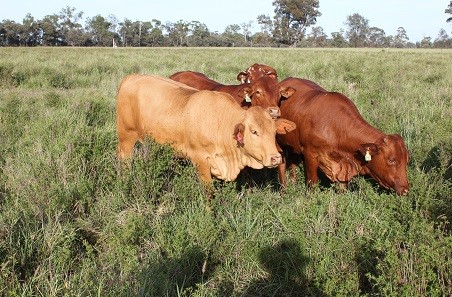Plan ahead for legume success

Declining pasture productivity may be widespread in northern Australia, but it’s not something producers have to live with.
Recent MLA-funded research, using legume trial sites up to 30 years old, has shown certain legume species such as Caatinga stylo and Desmanthus can improve soil nitrogen, lift livestock production by up to 100% and, with good management, persist for decades.
The MLA and Queensland Department of Agriculture and Fisheries project, which runs until 2021, is designed to help producers understand and implement options to improve pasture productivity in central and southern Queensland and to improve the reliability and performance of legumes in grass pastures.
However, project leader and senior pasture agronomist with Agri-Science Queensland, Gavin Peck, said while many producers accept the benefits of legumes, the sticking point is achieving successful establishment.
“One of the great outcomes from this work has been the development of best practice establishment methods for the Brigalow Belt bioregion, which has one of the toughest climates for establishing legumes into existing grass pastures,” he said.
“These results have application in other environments for improving reliability of legume establishment.
“We’re presently designing workshops to help producers understand these principles and select the best establishment techniques for their situation.”
Legume establishment can be approached in four stages: planning, fallowing to store soil moisture, planting and post-emergent care.
Planning
Producers need to plan legume sowings to give them the best chance of success. Key considerations are:
- which paddock?
- what legume?
- the ideal establishment method.
“It pays to sow down your best paddocks first and graze the pastures with your most valuable livestock to ensure the fastest return on investment,” Gavin said.
“More fertile soils with higher phosphorus levels and higher water-holding capacity are generally more profitable for sowing legumes. Soil tests can help identify the more fertile soils as well as whether fertiliser is required.”
Legume cultivars should be selected to suit the soil type and climate. Establishment methods can be altered to suit the legume selected and the condition of the pasture that it is to be planted into.
Fallowing
In episodic climates, fallowing is critical for storing enough soil moisture and reducing weed competition to ensure successful legume germination and strong early growth.
Gavin said rainfall records and soil moisture research suggests the general rule is the drier the location, the longer the fallow period.
“In the project’s research trials, 9–12-month fallows produced by far the best legume growth. However, in wetter years, shorter six-month fallows could store similar amounts of soil moisture and support similar legume growth,” he said.
“Long fallows of 9–12 months produced three to five times the legume dry matter of medium length fallows (four to six months).
“Where grass and weed loads are high, producers may need to use longer fallow periods and/or a post-emergent herbicide.”
Planting
Timing of sowing is critical. Small seeded legumes need a germinating rain with follow-up rainfall before dry-out.
For summer-growing legumes in the Brigalow Belt, January and February have higher probability for both germinating and follow-up rain, but stored soil moisture can dramatically increase the planting window.
Gavin emphasised the importance of good seed quality and correct seeding rates.
“Spending more on good quality seed is a better investment than cheap, poor quality seed. Seed purchases should be based on pure live seed per kilogram, not merely on cost,” he said.
Inoculation with the correct strain of rhizobia allows legumes to fix large amounts of nitrogen.
Gavin said rhizobia can die from drying out or overheating, which is a problem for summer sowing of small seeds near the surface of the soil.
“Water injection or other methods that place the rhizobia deeper in the soil can dramatically improve nodulation and nitrogen fixation,” he said.
“Good seed-to-soil contact is vital for germination, and how best to achieve that should determine the sowing method used such as, whether to direct drill or broadcast from a plane.”
Gavin said producers with loamy soils that are typically crusting and hard setting will get a better result from drilling, using zero till or sowing into dense pasture cover.
However, on self-mulching clay soils without excessive pasture cover, he said the project’s trials showed little benefit from drilling and, in these situations, broadcasting was often a better choice for producers without suitable equipment.
“If you’re going to direct drill, you must have good control of sowing depth,” he said.
“Small-seeded legumes are planted just below the surface, ideally 1cm or shallower, and if this can’t be achieved, broadcasting is a better option.
“Sowing too deep can result in the legumes not being able to emerge and therefore complete failure.
“Light harrows and rubber-tyred rollers (behind the seeder) can improve the seed-to-soil contact.”
Post-emergent care
Producers need to control competition from weeds and other grasses until the legumes are well established. Grazing needs to be managed with the aim of maximising seed set in the first year and seedling recruitment in the first few years.
In seasons with good stored soil moisture and legume growth, plants can be grazed lightly (as long as they aren’t being ripped out of the ground).
Light grazing can stimulate flowering in fast-growing vegetative plants and improve seed production before the plants run out of soil water.
In drier years, it is often better to allow the legumes to seed before grazing.
More information
Gavin Peck
T: 07 4529 4282
Email Gavin Peck
Go to futurebeef.com.au and search 'Gavin Peck' for a range of resources.
Click here for more information on establishing small-seeded legumes.



